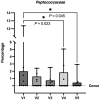Behavioral comorbidities treatment by fecal microbiota transplantation in canine epilepsy: a pilot study of a novel therapeutic approach
- PMID: 38978633
- PMCID: PMC11229054
- DOI: 10.3389/fvets.2024.1385469
Behavioral comorbidities treatment by fecal microbiota transplantation in canine epilepsy: a pilot study of a novel therapeutic approach
Abstract
Introduction: Anxiety and cognitive dysfunction are frequent, difficult to treat and burdensome comorbidities in human and canine epilepsy. Fecal microbiota transplantation (FMT) has been shown to modulate behavior in rodent models by altering the gastrointestinal microbiota (GIM). This study aims to investigate the beneficial effects of FMT on behavioral comorbidities in a canine translational model of epilepsy.
Methods: Nine dogs with drug-resistant epilepsy (DRE) and behavioral comorbidities were recruited. The fecal donor had epilepsy with unremarkable behavior, which exhibited a complete response to phenobarbital, resulting in it being seizure-free long term. FMTs were performed three times, two weeks apart, and the dogs had follow-up visits at three and six months after FMTs. Comprehensive behavioral analysis, including formerly validated questionnaires and behavioral tests for attention deficit hyperactivity disorder (ADHD)- and fear- and anxiety-like behavior, as well as cognitive dysfunction, were conducted, followed by objective computational analysis. Blood samples were taken for the analysis of antiseizure drug (ASD) concentrations, hematology, and biochemistry. Urine neurotransmitter concentrations were measured. Fecal samples were subjected to analysis using shallow DNA shotgun sequencing, real-time polymerase chain reaction (qPCR)-based Dysbiosis Index (DI) assessment, and short-chain fatty acid (SCFA) quantification.
Results: Following FMT, the patients showed improvement in ADHD-like behavior, fear- and anxiety-like behavior, and quality of life. The excitatory neurotransmitters aspartate and glutamate were decreased, while the inhibitory neurotransmitter gamma-aminobutyric acid (GABA) and GABA/glutamate ratio were increased compared to baseline. Only minor taxonomic changes were observed, with a decrease in Firmicutes and a Blautia_A species, while a Ruminococcus species increased. Functional gene analysis, SCFA concentration, blood parameters, and ASD concentrations remained unchanged.
Discussion: Behavioral comorbidities in canine IE could be alleviated by FMT. This study highlights FMT's potential as a novel approach to improving behavioral comorbidities and enhancing the quality of life in canine patients with epilepsy.
Keywords: behavioral comorbidities; canine idiopathic epilepsy; fecal microbiota transplantation; gastrointestinal microbiota; microbiota-gut-brain axis.
Copyright © 2024 Watanangura, Meller, Farhat, Suchodolski, Pilla, Khattab, Lopes, Bathen-Nöthen, Fischer, Busch-Hahn, Flieshardt, Gramer, Richter, Zamansky and Volk.
Conflict of interest statement
HV has served as a paid consultant in the field of epilepsy for Boehringer Ingelheim, CEVA Animal Health, Nestle Purina and served as contract researcher for: Nestle Purina, Desitin Pharma and Boehringer Ingelheim. JS and RP were employees of the Gastrointestinal Laboratory at Texas A&M University which offers microbiome assessment on a fee-for-service basis. JS was the Purina PetCare Endowed Chair for Microbiome Research and receives support for microbiome research through the Purina PetCare Research Excellence Funds. JS has also received consulting or speaking fees from Nestle Purina, IDEXX Laboratories, Royal Canin and Hill’s Pet Nutrition, Inc. AF participates in academia-industry partnerships with Nestle Purina and Vetoquinol. The remaining authors declare that the research was conducted in the absence of any commercial or financial relationships that could be construed as a potential conflict of interest. The reviewer AW declared a past collaboration with the authors HV to the handling editor.
Figures







References
LinkOut - more resources
Full Text Sources

